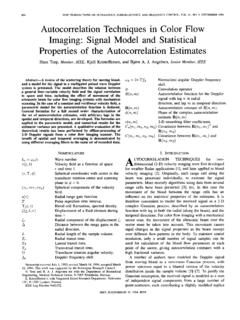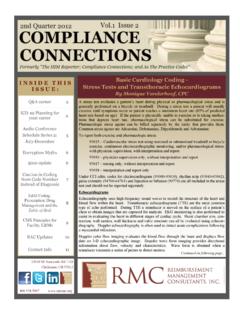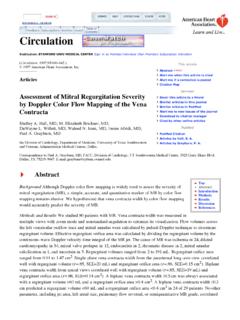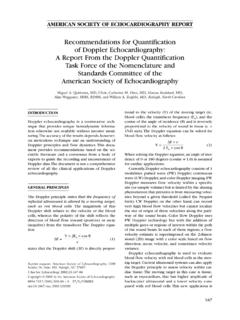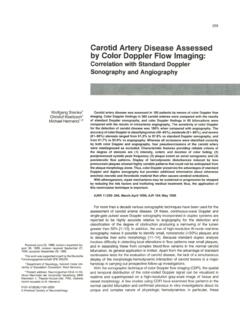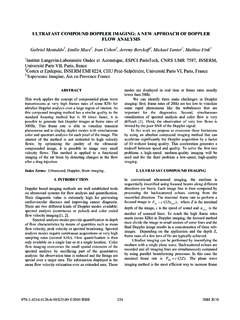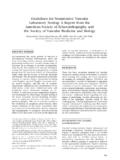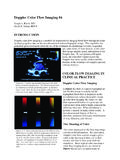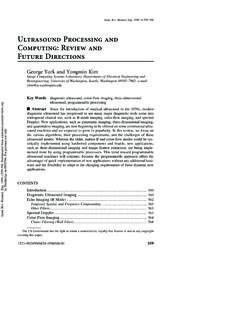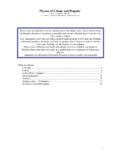Transcription of Signal processing in Ultrasound Doppler and Color Flow Imaging
1 H. Torp: Signal processing in Ultrasound Doppler and Color Flow Imaging page 1 Signal processing in Ultrasound Doppler and Color Flow Imaging Hans Torp, Department of Circulation and Medical Imaging NTNU, Trondheim, Norway Introduction This paper reveals methods for extracting information about the velocity field from the Doppler Signal . We shall restrict the analysis to time-discrete processes, and use the notation z(n); n = ..,-2,-1,0,1,2,.. (1) where z(n) is the complex sample at time t=nT. For the Fourier transform, we use capital letters =nnienzZ )()( (2) and the frequency parameter is in the range (- , ). For continuous wave Doppler , the sampling interval T can be chosen arbitrarily, whereas for pulsed wave Doppler the sampling interval T equals the inverse of the pulse repetition frequency.
2 By using the Doppler shift frequency Equation ( ), we get the following relation between the blood velocity v and the normalized angular frequency : Tcv02= (3) Here c is the speed of sound, T is the sampling interval, and 0 is angular transmitted frequency. In Section 2 the general principles for parameter estimation in a complex Gaussian process is treated, and in particular, the estimate of the autocorrelation function and the power spectrum. Section 3 covers the application of power spectrum analysis to continuous and pulsed wave Doppler instruments, and some practical algorithms for spectrum analysis, including FFT and chirp-Z transform. Signal processing for two-dimensional Doppler Color flow Imaging is treated in Section 4 , including spectral moment estimation, Color coding, and wall motion rejection.
3 The last section presents some recently developed methods for resolving velocity ambiguity in pulsed wave Doppler and Color flow Imaging . 2 Parameter estimation in a complex Gaussian process A. Properties of a complex Gaussian process A complex number z = x + iy is defined as a (zero mean) complex Gaussian variable if the real and imaginary parts are joint Gaussian with probability density function 2222*22222121)( yxzzeezp+ == (4) Note that the real and imaginary parts are independent random variables, and have equal variance . A complex Gaussian vector z = (z1,z2,..,zn) is defined by its probability density function H. Torp: Signal processing in Ultrasound Doppler and Color Flow Imaging page 2 zz1Tz21)2(1)( = epn (5) where the covariance matrix is given by i,j = < zi zj* > (6) and the vector zT is the transposed and complex conjugate of z.
4 Note that the expectation value <zi zj> = 0 for all i,j. A Signal z(t) with a continuous or discrete time parameter t is a complex Gaussian process if every random vector ( z(t1),.., z(tn) ) which is obtained by sampling the process at n points is a complex Gaussian vector. The number n is arbitrarily large. The process z(t) is completely determined by its autocorrelation function, which is a complex valued function of two time parameters R(t1,t2) = < z(t1) z(t2)* > (7) Note that R(t,t) = |z(t)|2 is real valued when t1 = t2. This quantity is the Signal power of the process. If the process is stationary, the stochastic properties are invariant under time shifts, the autocorrelation is only dependent on the time difference = t1-t2.
5 In this case the notation is simplified to R( ) = < z(t+ ) z(t)* > (8) The power spectrum of a stationary process z(t) is defined as the Fourier transform of the autocorrelation function = ieRdG)()( (9) Gz( ) Gx( ) x= Re {z} Figure 1. Power spectrum of a complex process z(t) (above), and its real part (below) H. Torp: Signal processing in Ultrasound Doppler and Color Flow Imaging page 3 ||- o o Figure 2. Complex demodulation of a real valued band pass process Note that the power spectrum is real valued and positive, even though the autocorrelation function is complex valued.
6 The next result shows that the complex Doppler Signal satisfies the definition for a complex Gaussian process. Result 1. The quadrature components of a (real valued) Gaussian band pass Signal form a zero-mean complex Gaussian process. The proof of this result may be found in [1, p 578]. For time discrete signals z(k), k = - ,..-1,0,1,..,+ , the power spectrum G( ) has the form of a Fourier series in the interval - < < , with the autocorrelation function R(m) as Fourier coefficients =mmiemRG )()( (10) = mieGdmR)(21)( An approximation to the power spectrum can be calculated by truncating the Fourier series after lag m= N. The resulting approximation to a square formed spectrum is shown in Figure 3 G( ) - G0G1 Figure 3. Truncated Fourier series expansion of the power spectrum G( ) on the interval [- , ] H. Torp: Signal processing in Ultrasound Doppler and Color Flow Imaging page 4 B.
7 Estimate of the autocorrelation function An estimator is a function of random variables which expresses a stochastic property of these variables. Example 1. ==NkNkzNz1)(1 =+=NkNkzmkzNmR1*)()(1)( (11) The complex valued functions zN and RN(m) are estimators of the mean value and autocorrelation function for the random process z(k). A general estimator f(x1,..,xN) is a random variable with probability density function determined by the joint probability distribution of (x1,..,xN). If the function f is non-linear, the probability density may have a non-Gaussian form, even though the variables (x1,..,xN) are jointly Gaussian distributed. Example 2. The estimator y = x2 has a 2 distribution with one degree of freedom, when the random variable x is Gaussian The quality of an estimator is usually described by two properties 1.
8 Bias is the difference between the expectation value and the correct value. 2. Variance is the second moment of the random variable. var (f) = < |f - <f>|2 > The estimators zN and RN(m) from example 1 are both unbiased (this follows directly from the definition). Note that the autocorrelation estimate RN(m) is a non-linear, complex valued function of the Signal samples z(n), and is therefore not necessarily a Gaussian variable. The probability distribution of RN(m) with m=1 for three different power spectra are shown in Figure 5. The scatter plots are obtained by computer simulations, and indicate that the probability distribution deviates significantly from a Gaussian distribution. 22121)(xexp = yeyxyp ==1)(2 Figure 4. The probability density function of a Gaussian variable x, to the left, and the estimator f(x)=x2, to the right H. Torp: Signal processing in Ultrasound Doppler and Color Flow Imaging page 5 Figure 5.
9 Scatter diagram of the autocorrelation estimator with lag m=1 for three different signals. To the right, a narrow band Signal with center frequency 1 = /2 to the left, a slightly more broadband Signal with 1 =3 /2, and in the middle, high-pass filtered white noise. In order to calculate the variance of non-linear estimators for a complex Gaussian process, the following result is needed to express 4th order moments by a sum of 2nd order moments. Result 2 If the four random variables z, u, v, w are complex, have a zero mean and are jointly Gaussian variables, the fourth order moments can be expressed by < z* u v* w> = <z* u> <v* w> + <z* w> <v* u> (12) This result is used here to calculate the variance of the autocorrelation estimate RN(m) as defined in Equation (11). Note that this estimator is complex valued when m 0.
10 The sum of the variance of the real and imaginary part of RN(m) is 22)()1(1)()(kRNkNmRmRNNkN = >= < (13) The variance expression can be derived by applying Equation (12). Note that the variance of RN(m) decreases with increasing bandwidth. C. Estimate of the power spectrum A finite segment {z(0),..,z(N-1)} from the zero mean complex Gaussian process is considered. A power spectrum estimator GN( ) for the process based on these Signal samples can be obtained as the square of the Fourier transform of this finite length sequence: 2)(1)( NNZNG= (14) = =10)()(NmmiNemzZ The spectrum estimate GN( ) is often called the periodogram. The periodogram can also be expressed as a Fourier transform of an autocorrelation function estimate. = =10)()(NmmiNNemRG (15) =+= 10*)()(1)(mNkNkzmkzNmR H. Torp: Signal processing in Ultrasound Doppler and Color Flow Imaging page 6 Note that the autocorrelation estimates R'N(m) are biased for m > 0, in contrast to the estimate RN(m) given in Equation (11).
